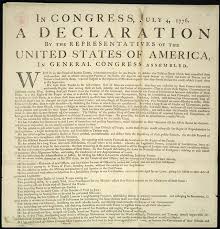
The Relationship Between the Declaration of Independence and the Constitution
This article originally appeared on the Independence Institute website.
I’m sometimes asked about the relationship between the Declaration of Independence and the Constitution.
Their connection is not difficult to understand.
The Declaration is a statement based on natural law. Natural law consists of fundamental principles of justice and right. Monotheists see natural law as deriving from the Creator. Polytheists see it as deriving from the supreme deity or deities. Atheists who believe in natural law, such as the late philosopher/novelist Ayn Rand, view it as a collection of rules inherent in the way the universe works.
The Founders’ Version of Natural Law
The men who approved the Declaration were monotheists (“endowed by their Creator with certain unalienable rights”). Their version of natural law had been worked out and popularized by writers such as John Locke. The fundamental characteristics of that version were
- people have equal dignity before God,
- God grants people rights or powers, some of which are transferable (alienable) and others not transferable (inalienable or unalienable),
- government is erected primarily to protect people’s rights,
- government is a fiduciary enterprise, subject to rules of public trust, and
- the people may alter government when it does not serve their purposes.
The Constitution, on the other hand, is a statement of positive law. Positive law consists of rules enforceable by governmental authority. There are many positive laws, but the Constitution was designed to be the supreme positive law.
The Founders believed that in a perfect world, positive law would be the same as natural law. In an imperfect world that is impossible, but we should try to make positive law approximate natural law as closely as feasible.
The Founders understood that people would (and should) accept some variations from the ideal. (“[M]ankind are more disposed to suffer, while evils are sufferable than to right themselves by abolishing the forms to which they are accustomed”). At some point, though, the gap between natural and positive law becomes too great to bear. This may be true for a particular law or for a set of laws—or even for an entire political system. In modern language we say the defective law or system “loses legitimacy.”
The Declaration served several purposes. First, it stated a natural law ideal (“We hold these truths to be self-evident. . . .”). Second, it showed how British legal practice varied from this ideal. Third, it explained that the variation had become too great to bear, justifying Americans in proclaiming their independence and thereby throwing Americans and their “British brethren” into a “state of nature” with each other. (Americans were not, however, thrown in a state of nature with their fellow Americans; most of their local ordinances continued to enjoy legitimacy.)
In other words, the Declaration argued that, as to Americans, the positive law of the British Empire had veered so far away from natural law that it no longer legitimately governed the colonies. It needed to be replaced. A similar event happened in our own time, when the peoples of eastern and central Europe overthrew their Communist regimes.
Particular laws or sets of laws may become illegitimate without the entire system being deemed so. For example, the 1960s civil rights advocates rejected laws mandating segregation, but only a few extremists in the movement rejected the American constitutional system. Similarly, a constitutional originalist or pro-life advocate today may well reject the legitimacy of the Supreme Court’s holding in Roe v. Wade without repudiating the entire political structure.
One common response to the illegitimacy of particular laws within a legitimate system is civil disobedience.
The Role of the Constitution
After Independence, the Declaration remained as a statement of America’s natural law ideals. The Constitution was adopted to move American positive law closer to those ideals. The Constitution did this in at least two principal ways:
- by substantive rules, and
- by imposing procedures designed to produce better results.
One instance of a substantive rule is the Contracts Clause of Article I, Section 10. The framers designed it to prevent states from using a common method of cheating people. The Contracts Clause did not apply to the federal government, but the framers subjected Congress to procedural mechanisms, like the president’s veto, that made it more difficult for Congress to pass laws cheating people.
The Constitution and Slavery
Although the Constitution was designed to move America closer to natural law principles, it was not a single-minded dash toward Utopia. The Founders could not produce a Constitution that approximated natural law in every way. For example, most Founders recognized that slavery was against natural law. But given the constraints of the time, tolerating slavery was the better of two bad choices. If the Constitution had banned slavery, it would not have met the nine-state threshold necessary for ratification. The result would have been a fragmented country. This likely would led to civil wars that lasted not just a few years (as our actual Civil War did), but decade after decade. That would have resulted in natural law violations greater even than slavery.
The Constitution Should Not Be Distorted to Achieve Natural Law Ends
Some people, including many liberals and libertarians, strain the Constitution to achieve what they see as its proper ends. They overlook the fact that the Constitution is a document of positive rather than natural law and that many of its provisions arise from prudential balancing among values. Moreover, as the supreme law of the land, the Constitution includes not only the Founders’ language, but their principles of interpretation. Their central principle of interpretation was to construe the document as the ratifiers understood it—not as the interpreter would like it to be.
The way to conform the Constitution more closely to natural law is not to pretend it means what it does not mean. The way to conform the Constitution more closely to natural law is to duly amend it.